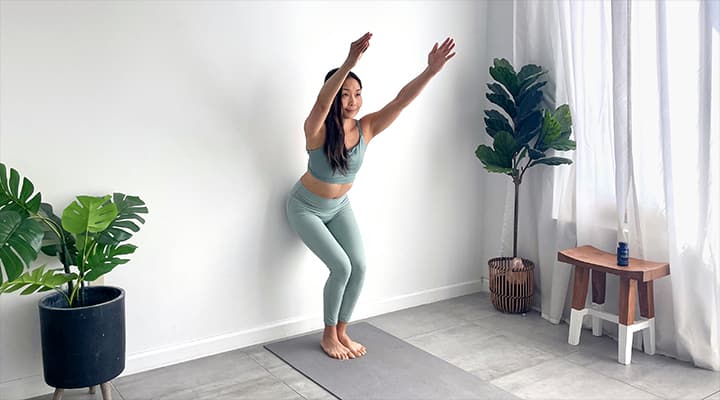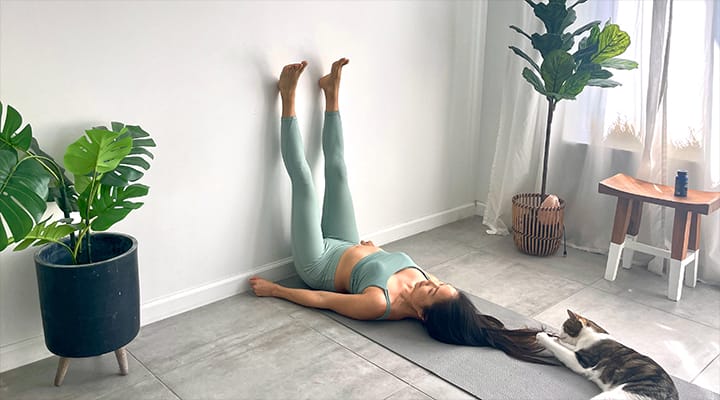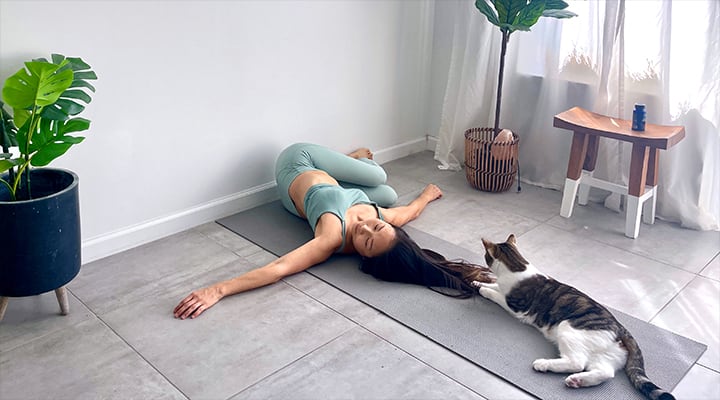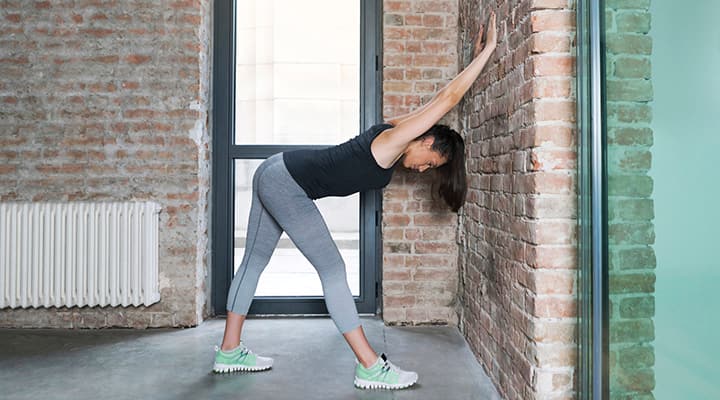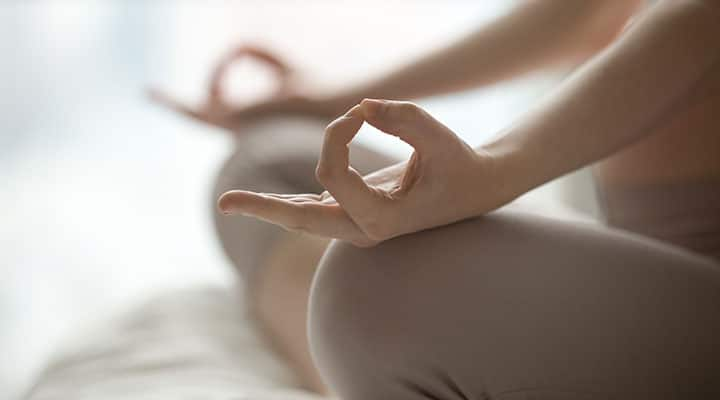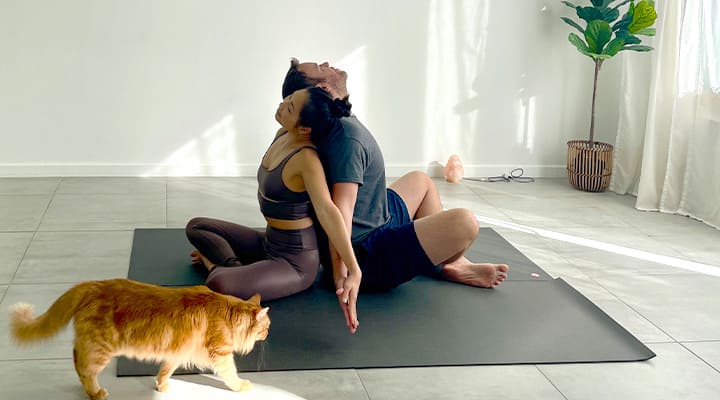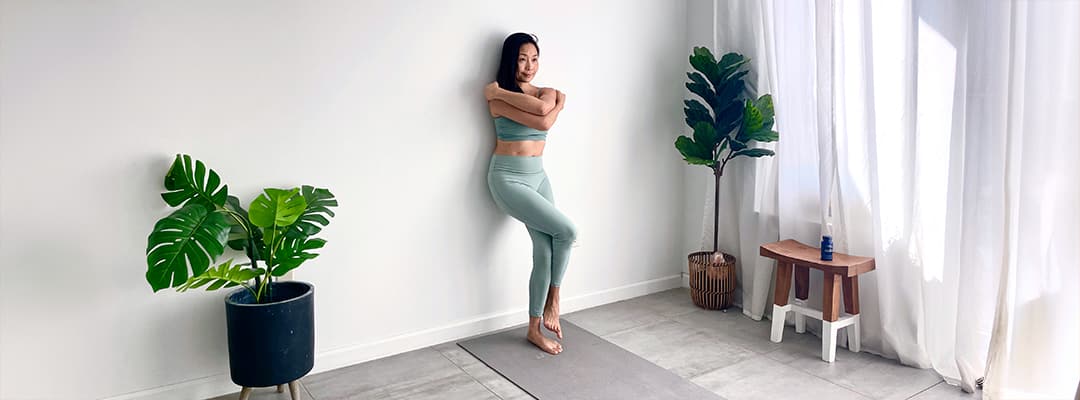
Wall Yoga For Beginners: More Than a Dozen Poses
Published: April 2024
Learning to swim can be scary, especially if you were introduced to it using the "throw 'em in the pool and let them figure it out" method. Experience shows a kind and gentle introduction to swimming works much better.
Yoga can be much the same way: "You want me to balance in that position for how long?" But the gentle assist of a nice, solid wall at your back can make the experience feel much safer. This physical aid can support poses that otherwise would seem too difficult, either because you're a beginner or are worried about stability (or both). Using a wall makes it easier to attempt standing balancing poses that are otherwise too scary for those who haven't yet developed the muscles or strength to hold them.
And considering that yoga supports both your heart and bones (not unlike a high-quality magnesium supplement!) there's really no reason not to do whatever you can to make this practice easier and more enjoyable.
Your wall awaits!
What is wall yoga?
You've seen the Instagram photos of someone doing a beautiful asana while balanced on a picturesque castle wall, but that isn't what wall yoga is. It is simply yoga poses done with the assist of a wall, not on top of it.
Wall yoga practice is great for anyone needing extra support in balancing yoga postures. This support can lead to a deeper pose and a better understanding of what the pose alignment should feel like.
13 wall yoga poses
Wall yoga poses can help elevate your practice. These beginner-friendly wall poses are a great place to start:
1. Dancer pose
- Stand facing the wall and place your fingertips lightly on it for balance.
- Shift your weight onto your right foot and bend your left knee, bringing your left foot toward your glutes.
- Reach back with your left hand and grab the inside of your left foot or ankle.
- Keep your right hand on the wall, maintaining balance.
- Lift your left foot up and back, pressing it into your hand.
- Hold this pose for several breaths, then switch sides.
Benefits
- Improves balance and concentration.
- Stretches shoulders, chest, thighs, groin, and abdomen.
- Strengthens legs and ankles.
- Opens the hips and shoulders.
2. Chair pose
- Stand with your back against the wall and your feet together.
- Inhale and raise your arms overhead.
- Exhale and bend your knees, lowering your hips as if sitting back into a chair.
- Keep your back flat, leaning over thighs at a 45-degree angle, with your buttocks pushed against the wall and your knees in line with your ankles.
- Hold the pose for several breaths.
Benefits
- Strengthens the thighs, glutes, and calves.
- Tones the core muscles.
- Improves balance and posture.
3. Eagle pose
- Stand with your back against the wall for support.
- Bend your knees slightly and cross your right thigh over your left thigh.
- Hook your right foot behind your left calf, if possible.
- Beginners: Cross left hand over right shoulder and right hand under left armpit or shoulder.
- Advanced: Extend your arms out to the sides at shoulder height, then cross your right arm over your left arm. Then bend your elbows and bring your palms together or press the backs of your hands together.
- Hold this pose for several breaths, then switch sides.
Benefits
- Improves balance and focus.
- Stretches the shoulders, upper back, and outer thighs.
- Strengthens the legs and ankles.
- Helps to relieve tension in the shoulders and neck.
4. Puppy pose
- Stand a foot away, facing the wall.
- Stretch your arms forward so palms touch the wall, then walk hands down while keeping palms connected to the wall.
- Lean your chest toward the wall, getting as close as possible.
- Press your palms into the wall and draw your chin close or even touching the wall, reaching your chest toward the wall.
- Hold for several breaths.
Benefits
- Stretches the shoulders, neck, chest, and upper back.
- Relieves tension in the neck and shoulders.
- Calms the mind.
- Opens the heart and improves posture.
5. Wall-supported tree pose
- Stand with your side body facing the wall.
- Place your outside foot against the opposite calf, either below or above the knee.
- Reach arms overhead, resting one arm against the wall for balance, palm out, and keeping shoulders relaxed.
- Hold this pose for several breaths, then switch sides.
Benefits
- Improves balance and concentration.
- Strengthens ankles and legs.
- Opens hips and stretches thighs.
6. Wall-supported forward fold (also an inversion yoga pose)
- Stand facing the wall and place your hands on the wall.
- Walk your feet back until your torso is parallel to the ground.
- Keep your hands on the wall for support and allow your head to hang between your arms.
Benefits
- Stretches hamstrings and calves.
- Relieves tension in the spine and neck.
- Calms the mind.
Explore Our Best Active Lifestyle & Fitness Supplements
7. Wall-supported shoulder opener
- Stand with your side facing the wall and place one hand on the wall at shoulder height.
- Rotate away from the wall, opening your chest toward the ceiling.
- Hold this pose for several breaths, then switch sides.
Benefits
- Releases tension in shoulders and chest.
- Supports healthy posture.
8. Wall-supported lunge twist
- Stand facing the wall and step right foot back into a lunge position.
- Place your right hand on the wall and twist your torso toward the left side, reaching the left arm behind you.
- Hold this pose for several breaths, then switch sides.
Benefits
- Stretches hip flexors and thighs.
- Promotes spinal mobility.
- Supports healthy digestion.
The following are restorative poses, in which the legs are supported upside down. Inversions like viparita karani turn wall poses into passive stretches, which allows the body to release tension without trying as the body weight works with gravity. This practice helps the body to relax.
9. Legs up the wall (or viparita karani)
- Sit sideways against the wall with your right hip touching it.
- Swing your legs up the wall as you lie back on your yoga mat, perpendicular to the wall, keeping your arms by your sides.
- Hold this pose for several breaths.
Benefits
- Promotes relaxation.
- Encourages circulation.
10. Wide-legged straddle with legs up the wall
- Start with legs up the wall.
- Slide your feet apart until there's a gentle stretch inside of the hips and thighs. Try to keep your legs as straight as possible without locking the knees. Alternatively, keep a small bend in the knees and slowly work your way into straighter legs.
- Continue to widen the legs once you feel more comfortable to deepen the stretch.
- Hold this pose for several breaths.
Benefits
- Opens hips and groin.
- Stretches glutes and piriformis.
- Releases tension in lower back.
11. Wall-supported pigeon pose
- Start with legs up the wall.
- Bend right knee and place ankle below the opposite knee.
- Slowly inch the left foot down the wall while keeping the hips square and keeping your low back on the mat.
- Continue until gentle stretch sensation is achieved and hold for at least five breaths. Walk both legs up the wall to reset and repeat on the other side.
Benefits
- Opens hips and groin.
- Stretches glutes and piriformis.
- Releases tension in lower back.
12. Wall-supported reclined twist
- Start with your legs up the wall.
- Extend arms out wide at shoulder height.
- Bend both knees and drop them onto the right side of the floor so the knees and feet stack. (Beginners can add a pillow or folded blanket between the thighs.)
- Hold the pose for five breaths or more. Reset and switch to the other side.
Benefits
- Stretches chest and throat.
- Improves posture.
13. Wall-supported butterfly
- Start with legs up the wall.
- Extend arms out wide at shoulder height.
- Bend knees in toward your chest.
- Open knees as wide as you can with the outside points toward the wall.
- Press the soles of your feet together and slide your feet down as low as possible.
- Stay in position for 10 slow breaths in and out of your nose.
Benefits
- Opens hips and inner thigh muscles.
What is the purpose of wall yoga?
Whether you're a seasoned yogi or just starting out, wall yoga poses can significantly deepen your yoga practice and enhance your flexibility, strength, and overall well-being. With the support of a wall, you can explore new variations of familiar poses, improve your alignment, and experience deeper stretches.
Research shows the many benefits of yoga, both for physical and mental health.
Not only does yoga practice promote muscle strength, balance, mobility, and lower body flexibility; it also encourages healthy stress management. A review of 27 studies found yoga postures helped relieve back discomfort and encouraged physical functioning. Studies have also associated yoga with beneficial effects for bone health, brain health and more.
Is wall yoga good for beginners?
Yes. Having a wall to lean on allows beginners to maintain otherwise challenging balancing poses without fear of falling. In the same way, intermediate yogis can learn to master advanced poses with the aid of the wall, letting the wall support their weight and learning to trust the process. For any level, a wall can provide a much deeper level of comfort and relaxation because the physical support allows the body to give into the yin energy of restorative yoga poses.
In addition, the wall gives the yogi full permission to lean in and let go physically, which can help with the mental and emotional release that restorative yoga provides. It also allows the body to experience the benefits of inversions with no scary hanging or dangling off bars or the advanced postures of headstands or handstands.
How else can I support mental and physical health?
Targeted nutrition can be the perfect complement to your wall poses. Like yoga, magnesium supplementation has benefits for bone health, brain health and a healthy mood. Other mood supplements can help you shrug off stress, much like a downward-facing dog pose.
Whether you have a dedicated yoga space or just a blank wall, you have everything you need for your wall poses. Remember to listen to your body and modify the intensity of these poses to suit your level of flexibility. Stay connected to how your body feels, and access deeper breathing when wall poses feel hard.
Wondering which nutrients can help support the healthy mood effects of yoga? Our health needs quiz can give you a personal recommendation that fits your lifestyle.
About the Author: Renee Kwok is yoga instructor who has taught various yoga styles and levels for more than 13 years. Her passion is showing others how to achieve clear mindset, vitality and wellness by connecting the mind and body. When she’s not teaching yoga, she offers Reiki energy therapy and intentional journaling, and she continues to explore healthy alternatives to nourish the body and mind as we age gracefully.
References
- Anheyer D, et al. "Yoga for treating low back pain: a systematic review and meta-analysis." Pain. April 2022. https://pubmed.ncbi.nlm.nih.gov/34326296/
- Fishman LM. "Yoga and Bone Health." Orthop Nurs. May-June 2021. https://pubmed.ncbi.nlm.nih.gov/34004616/
- Krause-Sorio B, et al. "Yoga Prevents Gray Matter Atrophy in Women at Risk for Alzheimer's Disease: A Randomized Controlled Trial." J Alzheimers Dis. 2022. https://pubmed.ncbi.nlm.nih.gov/35275541/
- Lemay V, et al. "Impact of a Yoga and Meditation Intervention on Students' Stress and Anxiety Levels." Am J Pharm Educ. June 2019. https://pubmed.ncbi.nlm.nih.gov/31333265/
- Shin S. "Meta-Analysis of the Effect of Yoga Practice on Physical Fitness in the Elderly." Int J Environ Res Public Health. November 2021. https://www.ncbi.nlm.nih.gov/pmc/articles/PMC8583600/
- Zhu F, et al. "Yoga compared to non-exercise or physical therapy exercise on pain, disability, and quality of life for patients with chronic low back pain: A systematic review and meta-analysis of randomized controlled trials." PLoS One. September 2020. https://pubmed.ncbi.nlm.nih.gov/32870936/
- Ziv A, et al. "Yoga as an intervention to promote bone and mental health in adolescent females with anorexia nervosa: a pilot study." Eat Disord. September 2023. https://pubmed.ncbi.nlm.nih.gov/37016582/

